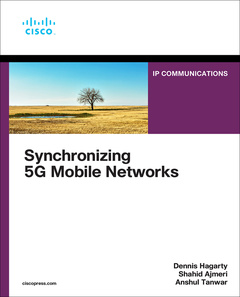Foreword xxi
Introduction xxiii
Part I Fundamentals of Synchronization and Timing
Chapter 1 Introduction to Synchronization and Timing 1
Overview of Time Synchronization 1
What Is Synchronization and Why Is It Needed? 3
What Is Time? 10
How Can GPS Provide Timing and Synchronization? 13
Accuracy Versus Precision Versus Stability 15
Summary 16
References in This Chapter 16
Chapter 1 Acronyms Key 16
Further Reading 17
Chapter 2 Usage of Synchronization and Timing 19
Use of Synchronization in Telecommunications 20
Use of Time Synchronization in Finance, Business, and Enterprise 28
Industrial Uses of Time—Power Industry 33
Summary 34
References in This Chapter 34
Chapter 2 Acronyms Key 35
Chapter 3 Synchronization and Timing Concepts 39
Synchronous Networks Overview 40
Clocks 54
Sources of Frequency, Phase, and Time 66
Timing Distribution Network 82
Consumer of Time and Sync (the End Application) 88
Summary 89
References in This Chapter 89
Chapter 3 Acronyms Key 92
Further Reading 95
Part II SDOs, Clocks, and Timing Protocols
Chapter 4 Standards Development Organizations 97
International Telecommunication Union 98
International Mobile Telecommunications 104
3rd Generation Partnership Project 106
Institute of Electrical and Electronics Engineers 109
European Telecommunications Standards Institute 116
Internet Engineering Task Force 118
Radio Access Network 120
MEF Forum 126
Society of Motion Picture and Television Engineers and Audio Engineering Society 127
Summary 128
References in This Chapter 129
Chapter 4 Acronyms Key 132
Further Reading 137
Chapter 5 Clocks, Time Error, and Noise 139
Clocks 139
Time Error 154
Holdover Performance 169
Transient Response 172
Measuring Time Error 173
References in This Chapter 175
Chapter 5 Acronyms Key 175
Further Reading 177
Chapter 6 Physical Frequency Synchronization 179
Evolution of Frequency Synchronization 180
BITS and SSU 181
Clocking Hierarchy 185
Synchronous Ethernet 187
Enhanced Synchronous Ethernet 189
Clock Traceability 189
Synchronization Network Chain 197
Clock Selection Process 199
Timing Loops 201
Standardization 207
Summary 207
References in This Chapter 208
Chapter 6 Acronyms Key 209
Further Reading 211
Chapter 7 Precision Time Protocol 213
History and Overview of PTP 214
PTP Versus NTP 215
IEEE 1588-2008 (PTPv2) 216
PTP Clocks 242
Profiles 250
PTP Security 273
IEEE 1588-2019 (PTPv2.1) 275
Summary 280
References in This Chapter 280
Chapter 7 Acronyms Key 283
Part III Standards, Recommendations, and Deployment Considerations
Chapter 8 ITU-T Timing Recommendations 289
Overview of the ITU 290
ITU-T Study Group 15 and Question 13 291
Reading the Recommendations 299
ITU-T Physical and TDM Timing Recommendations 299
ITU-T Recommendations for Frequency in Packet Networks 310
ITU-T Packet-Based Timing Recommendations 316
Possible Future Changes in Recommendations 340
Summary 341
References in This Chapter 341
Chapter 8 Acronyms Key 342
Further Reading 346
Chapter 9 PTP Deployment Considerations 347
Deployment and Usage 348
Factors Impacting Timing Performance 380
Parameters for Timing Performance 383
Clock Performance 401
Budgeting End-to-End Time Error 419
Network Holdover 422
Packet Network Topologies 424
Packet Transport 426
Non-Mobile Deployments 430
Summary 434
References in This Chapter 435
Chapter 9 Acronyms Key 437
Further Reading 442
Part IV Timing Requirements, Solutions, and Testing
Chapter 10 Mobile Timing Requirements 443
Evolution of Cellular Networks 444
Timing Requirements for Mobility Networks 448
Timing Requirements for LTE and LTE-A 455
Evolution of the 5G Architecture 478
5G New Radio Synchronization Requirements 496
Summary 509
References in This Chapter 510
Chapter 10 Acronyms Key 512
Further Reading 517
Chapter 11 5G Timing Solutions 519
Deployment Considerations for Mobile Timing 520
Frequency-Only Deployments 535
Frequency, Phase, and Time Deployment Options 538
Midhaul and Fronthaul Timing 550
Timing Security and MACsec 556
Summary 564
References in This Chapter 565
Chapter 11 Acronyms Key 567
Further Reading 571
Chapter 12 Operating and Verifying Timing Solutions 573
Hardware and Software Solution Requirements 574
Writing a Request for Proposal 587
Testing Timing 590
Automation and Assurance 629
Troubleshooting and Field Testing 635
Summary 648
Conclusion 649
References in This Chapter 649
Chapter 12 Acronyms Key 653
Further Reading 658
9780136836254, TOC, 5/3/2021




